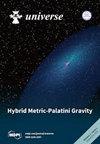Fluctuations and Correlations of Conserved Charges Serving as Signals for QGP Production: An Overview from Polyakov Loop Enhanced Nambu–Jona-Lasinio Model
IF 2.5
4区 物理与天体物理
Q2 ASTRONOMY & ASTROPHYSICS
引用次数: 0
Abstract
Quark–Gluon plasma driven by the strong force is subject to the conservativeness of the baryon number, net electric charge, strangeness, etc. However, the fluctuations around their mean values at specific temperatures and chemical potentials can provide viable signals for the production of Quark–Gluon plasma. These fluctuations can be captured theoretically as moments of different orders in the expansion of pressure or the thermodynamic potential of the system under concern. Here, we look for possible explanations in the methodologies used for capturing them by using the framework of the Polyakov–Nambu–Jona-Lasinio (PNJL) model under the 2 + 1 flavor consideration with mean-field approximation. The various quantities thus explored can act to signify meaningfully near the phase transitions. Justifications are also made for some of the quantities capable of serving necessarily under experimental scenarios. Additionally, variations in certain quantities are also made for the different collision energies explored in the high-energy experiments. Rectification of the quantitative accuracy, especially in the low-temperature hadronic sector, is of prime concern, and it is also addressed. It was found that most of the observables stay in close proximity with the existing lattice QCD results at the continuum limit, with some artifacts still remaining, especially in the strange sector, which needs further attention.作为 QGP 生成信号的守恒电荷的波动和相关性:波利亚科夫环增强南布-若纳-拉西尼奥模型概述
由强力驱动的夸克-胶子等离子体受制于重子数、净电荷、奇异性等的保守性。然而,在特定温度和化学势下,围绕其平均值的波动可以为夸克-胶子等离子体的产生提供可行的信号。从理论上讲,这些波动可以被捕捉为压力膨胀或所关注系统的热力学势的不同阶矩。在这里,我们利用波利亚科夫-南布-若纳-拉西尼奥(PNJL)模型的框架,在平均场近似的 2 + 1 味考虑下,寻找捕捉这些波动的方法中可能存在的解释。由此探索出的各种量可以在相变附近起到有意义的指示作用。此外,还为某些能够在实验情况下发挥必然作用的量提出了理由。此外,还针对高能实验中探索的不同碰撞能量对某些量进行了调整。定量精确度的修正,尤其是在低温强子部门,是人们最关心的问题,也得到了解决。研究发现,大多数观测指标在连续极限上与现有的格子 QCD 结果保持接近,但仍然存在一些假象,特别是在奇异部门,这需要进一步关注。
本文章由计算机程序翻译,如有差异,请以英文原文为准。
求助全文
约1分钟内获得全文
求助全文
来源期刊

Universe
Physics and Astronomy-General Physics and Astronomy
CiteScore
4.30
自引率
17.20%
发文量
562
审稿时长
24.38 days
期刊介绍:
Universe (ISSN 2218-1997) is an international peer-reviewed open access journal focused on fundamental principles in physics. It publishes reviews, research papers, communications, conference reports and short notes. Our aim is to encourage scientists to publish their research results in as much detail as possible. There is no restriction on the length of the papers.
 求助内容:
求助内容: 应助结果提醒方式:
应助结果提醒方式:


